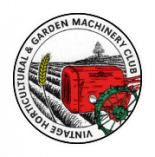Home › Forums › General › Help and information › Identification needed for unknown engine
- This topic has 35 replies, 5 voices, and was last updated 5 years, 7 months ago by
 trusty220.
trusty220.
-
AuthorPosts
-
November 23, 2019 at 4:18 pm #32710
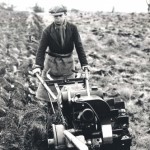 trusty220Keymaster
trusty220KeymasterHello, All,
I’ve just bought this engine from a place not far from me. The original owner had died and the contents of his workshop were being sold off to interested people. The interesting thing about the story is that he used to be a director of Albion Engineering in Birmingham and he had quite a few items that he’d put together as test pieces or demonstration items in order to sell his wares.
I’ve never heard of an Albion engine before and my suspicion is that it’s an off-the-shelf engine that he’s re-badged himself. It has certain similarities to Villiers engines- can anyone identify it for me?
November 23, 2019 at 10:28 pm #32719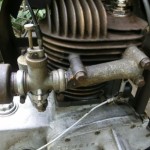 wristpinParticipant
wristpinParticipantNot sure about any Villiers association as I can’t recollect ever seeing an engine from them that has a crankcase split horizontally along the crank line. It was the Japanese who introduced that design to motor cycle engines while British lumps were still vertically split and dripping oil.
November 24, 2019 at 1:07 am #32720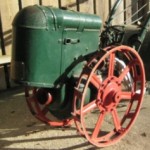 jtg1Participant
jtg1ParticipantThe way the cj mag is mounted. Might imply j.a.p history.
November 24, 2019 at 8:26 am #32721andyfrost
ParticipantHave you checked the thread rates , that would give some sort of start. I would agree with Angus , it’s as far from a Villiers as I’ve ever seen.
Andy.
November 24, 2019 at 8:42 am #32722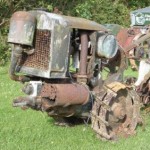 charlieKeymaster
charlieKeymasterMy thoughts were BSA
November 24, 2019 at 11:49 am #32723 trusty220Keymaster
trusty220KeymasterIt makes me feel better now; I thought somebody was going to reply and say that it was definitely a so-and-so! I think I’ll keep exploring and take some of the cowlings off and give it a clean up to see if it reveals anything.
Another avenue may be the magneto type if I can find a plate on it, then look up the applications.
Keep trying!
November 24, 2019 at 2:54 pm #32724 trusty220Keymaster
trusty220KeymasterStill no idea yet, but the head gasket looks very much a like a one-off. See for yourself on the photo’s, and the head bolts don’t follow normal practice either with only six of them. Two holes for the head bolts are very close to a cooling fin which makes it impossible to put a socket onto. All of the bolt heads are severely wasted away and I’ve had to cut most of them off to get anywhere with it, otherwise I’d have some idea if they are metric, AF or Whitworth sizes.
I suppose I’m just going to have to measure the threads and do the job properly!
November 24, 2019 at 6:12 pm #32731 trusty220Keymaster
trusty220KeymasterI reckon it’s of British origin. The head studs are 3/8″ Whitworth (16 threads per inch) at the bottom where they screw into the barrel and 3/8″ BSF (20 threads per inch) at the top where the head nuts screw on.
I can’t find any identification on the Wipac CJ magneto, although the master parts listing that I have lists JAP and Petter as the only two makes that use the CJ.
I think I’ll have to dig a little deeper and see what’s inside the crankcase.
November 25, 2019 at 6:54 pm #32733andyfrost
ParticipantGeoff , that may not be the original magneto , it could well have been fitted with a A series from new. it may be worth checking all the users of the A series mags ….just a thought.
Andy.
November 26, 2019 at 7:48 am #32734 trusty220Keymaster
trusty220KeymasterA good point. It’s so easy to overlook the obvious when you’re trying to find that elusive clue!
Such a shame that it hasn’t been stored in a dry place. Everything is corroded and wasted away; even the magneto cap screws didn’t give in without a fight, then when I got the cap off it was full of white powder. At least it shouldn’t be too difficult to replace the mag and it won’t affect the originality of the engine.
November 26, 2019 at 6:15 pm #32736 trusty220Keymaster
trusty220KeymasterA few more clues tonight. The flywheel nut is left-handed and fitted with a locking tab- have a look at the photo. I can’t shift the flywheel by all of the short-cut methods, so I’m going to have to make a puller to get it off.
Until the flywheel is off I can’t separate the crankcase halves. The split is through the main bearings and the halves are secured with bolts and nuts. At first I thought they were studs with nuts on, but scraping away the rust and dirt revealed bolt heads at the top which go through to the bottom half where they are nutted up. Very unusual.
Any ideas yet?
November 26, 2019 at 7:36 pm #32742andyfrost
ParticipantI’m leaning on the side that it could well be Albions own engine , you may well have a prototype that never actually got onto production.
Albion made a vast number of products , remember they even made pistols for the war effort , they seemed to be able to turn their hands to almost anything , so a stationary engine would not have been beyond them.Andy.
November 26, 2019 at 9:41 pm #32743 trusty220Keymaster
trusty220KeymasterI’m starting to think the same myself. It does have one or two features that a mass produced engine wouldn’t have, but until I’m sure I will keep digging away at it in the hope that the conrod, piston or crankshaft will have some identification mark.
You may even see it on a Trusty yet, Andy!
November 26, 2019 at 10:12 pm #32744 wristpinParticipant
wristpinParticipantIt certainly has an over engineered look , the bottom end would be more at home as the casing of a right angle drive box. If it is a home made engine would the maker have gone to the trouble of manufacturing his own finned flywheel or did Villiers or some other contemporary engine maker unknowingly provide that? Any clues such as casting numbers inside the flywheel?
November 27, 2019 at 7:16 pm #32745 trusty220Keymaster
trusty220KeymasterHere are tonight’s pictures. It’s turning into quite a saga, isn’t it?
To recap, I made a puller to tension the flywheel and was intending to heat it whilst under tension. After I put a tension on the puller I thought that I’d tap the puller with a copper mallet and to my surprise the puller became loose. I kept turning and the flywheel kept coming- it’s not on a taper as in usual practice but is on a parallel shaft with a steel key, all held together with a large nut on a left-handed thread.
The flywheel does have a number cast into it, but it’s probably an “off-the-shelf” item that has been modified to fit this engine.
Once the flywheel was off it gave access to three screws that held the rear half of the cowling on. After removing this, four nuts came off easily and the main bearing/oil seal carrier was taken off to reveal a ball race behind.
I’ve left the rest for another night and filled the bore with WD40 to soak through and hopefully free the piston.
Have a look at the latest photo’s.
-
AuthorPosts
- You must be logged in to reply to this topic.
